

Take a look at your to-do-list. If it’s like mine it may be something fairly simple and straightforward. My to-do-list is just a post-it note. But, I know people who use a bullet journal, an app like Todoist or Wunderlist, or have replaced their to-do-list with block scheduling.
The right or wrong conundrum.
There’s really no right or wrong way when it comes to your to-do-list. If there is one common trend, however, it’s that most of of to-do-lists are benign. Do they keep you organized and productive? Sure. But, they’re not ambitious enough to keep you motivated when you need a boost.
How to re-think.
If that’s the case, then you may want to rethink how you create your to-do-lists and follow in the steps in one of the greatest thinkers of all-time; Leonardo da Vinci.
Da Vinci’s ambitious to-do-list explained.
According to historian and author Toby Lester — Leonardo da Vinci’s notebook contained a marvelous to-do-list that demonstrates just how motivated and driven he was. It also shows how dedicated he was to learning and creating — even if it seemed impossible.
Robert Krulwich of NPR translated one of Leonardo Da Vinci’s lists from the early 1490. It’s impressive, to say the least. Here’s what it looked like:
- [Calculate] the measurement of Milan and Suburbs
- [Find] a book that treats of Milan and its churches, which is to be had at the stationer’s on the way to Cordusio
- [Discover] the measurement of Corte Vecchio (the courtyard in the duke’s palace).
- [Discover] the measurement of the castello (the duke’s palace itself)
- Have the master of arithmetic to show you how to square a triangle.
- Get Messer Fazio (a professor of medicine and law in Pavia) to show you about proportion.
- Get the Brera Friar (at the Benedictine Monastery to Milan) to show you De Ponderibus (a medieval text on mechanics)
- [Talk to] Giannino, the Bombardier, re. the means by which the tower of Ferrara is walled without loopholes (no one really knows what Da Vinci meant by this)
- Ask Benedetto Potinari (A Florentine Merchant) by what means they go on ice in Flanders
- Draw Milan
- Ask Maestro Antonio how mortars are positioned on bastions by day or night.
- [Examine] the Crossbow of Mastro Giannetto
- Find a master of hydraulics and get him to tell you how to repair a lock, canal and mill in the Lombard manner
- [Ask about] the measurement of the sun promised me by Maestro Giovanni Francese
- Try to get Vitolone (the medieval author of a text on optics), which is in the Library at Pavia, which deals with the mathematic.
Instead of being intimidated by his genius and ambition — get inspired by da Vinci’s to-do-list.
Drive and curiosity.
Just think if you had just a fraction of his drive and curiosity. You probably would be one of the most productive people around.
Of course, that’s easier said than done. But, here’s a couple of ways that you can get started on creating your own da Vinci-like to-do-list.
Always Carry a Notebook
Leonardo da Vinci wasn’t the only successful person to carry around a notebook. Isaac Newton, Beethoven. Benjamin Franklin, Thomas Edison, John D. Rockefeller, Bill Gates, and Richard Branson are all known for carrying with them a pocket notebook. The reason?
Well, Aristotle Onassis, the famous Greek shipping tycoon, explained it best:
“Always carry a notebook. Write everything down. When you have an idea, write it down. When you meet someone new, write down everything you know about them. That way you will know how much time they are worth. When you hear something interesting, write it down. Writing it down will make you act upon it. If you don’t write it down you will forget it. THAT is a million dollar lesson they don’t teach you in business school!”
But, your notebook isn’t just for remember things and jotting down your thoughts.
Rip-out a page…
Sheryl Sandberg uses her notebook as a daily planner where she scribbles her to-do-lists. After she’s completed each item on her list, she rips the page out. It motivates her to stay on-track.
My suggestion would be to use a bullet journal, which is what da Vinci was kind of doing. This way you have once notebook to write down your ideas and keep track of your tasks and events for the day.
Give Your Mind a Chance to Break Free
As noted by NPR, letting your mind “let go, float free,” is essential for creative minds. In fact, when we stop focusing and let our minds wander can be beneficial.
What…? Huh…? A positive…?
To support this claim there has been research studying people with ADHD and how creative they are. Because their minds are inhibited or restrained, Scientific American reports that people with ADHD can, “reach higher levels of creative thought and achievement than people without these characteristics,” such as “higher levels of spontaneous idea generation, mind wandering, daydreaming, sensation seeking, energy, and impulsivity.”
Even if you don’t possess these characteristics, don’t hesitate in letting your brain break free by doodling or inquiring about seemingly random thoughts in your notebook and to-do-lists. You never know where that journey will take you.
Never Stop Being Curious
In Walter Isaacson’s biography, Leonardo da Vinci, the author writes:
“My favorite gems in his notebooks are his to-do lists, which sparkle with his curiosity. One of them, dating from the 1490s in Milan, is that day’s list of things he wants to learn. ‘The measurement of Milan and its suburbs,’ is the first entry. This has a practical purpose, as revealed by an item later in the list: ‘Draw Milan.’ Others show him relentlessly seeking out people whose brains he could pick: ‘Get the master of arithmetic to show you how to square a triangle… Ask Giannino the Bombardier about how the tower of Ferrara is walled… Ask Benedetto Protinari by what means they walk on ice in Flanders… Get a master of hydraulics to tell you how to repair a lock, canal and mill in the Lombard manner… Get the measurement of the sun promised me by Maestro Giovanni Francese, the Frenchman.’ He is insatiable.”
Isaacson continues — “Over and over again, year after year, Leonardo lists things he must do and learn.Some involve the type of close observation most of us rarely pause to do,” such as ‘Observe the goose’s foot: if it were always open or always closed the creature would not be able to make any kind of movement.” Another gem, “Describe the tongue of the woodpecker.”
What is the “duck’s foot” in your life? Goose?
Like da Vinci, you should always be curious. Science has found that being curious can help you learn and retain knowledge, grow personally, and become more open to new experiences, which can squash stereotypes.
So, the next time you’re curious, jot that thought down into your to-do-list so that you can learn more about the thoughts and ideas occupying your mind.
Don’t Be Afraid to Set Big Goals
“Draw Millan” is an incredibly large and ambitious goal. But, there’s nothing wrong with setting goals of this magnitude. That’s because setting big goals gives you a chance to:
- Dream. When we dream big, we get excited about the prospect of achieving that dream. To me, that’s a sign for most entrepreneurs.
- Make long term improvements. Big goals force us to expand our vision. By doing so we must realize the “structural changes” needed to make that goal become a reality.
- Become more resilient in the short term. In order to achieve a big goal, you can’t waste time. This makes you more resilient in the short term. For example, you may not feel like working today, but if you don’t, your business will fail. That may help you get out of bed and get to work.
- Confront reality. Setting big goals makes you get real with yourself. You have to realize what you need to do to make the goal a reality. Sometimes it works, but maybe you realize that it’s best to cut your losses and move on.
- Develop powerful habits. If you want to achieve a goal, then you’ll need to form new habits to actually accomplish your goal. Without effective systems and processes you won’t be able to reach your goals.











Albert Costill
My name is Albert Costill and I'm a content marketer at Calendar. If I can help people become more productive in my journey, even better. If you ever have a question about your Calendar or how you can use it - - don't hesitate to reach out. I'm a Calendar Pro.